Ninth Day
We got up at 7:30 this morning. In our hostel we did not have breakfast, so we had to find some place to eat. This was a pretty hard task early in the morning.

http://www.big-italy-map.co.uk/map-of-toscana-map.htm
Today we were heading to Florence or as the Italians call it Firenze. We were very excited about seeing this golden city.
Driving and parking in Florence is very hard, so we parked the van as soon as we got close to the city and took the bus to go to the important places.
Florence
Florence is a small city, located in the Arno River valley, and surrounded by olive-planted hills on the north and south. It extends west and slightly east along the Arno valley with suburbs and light industry. The centro storico (historic center), where visitors spend most of their time, is a tight tangle of medieval streets and piazze (squares). Most of Florence, and the majority of the tourist sites, lie north of the river, with a vintage artisan's working-class neighborhood wedged in between the Arno and the hills on the south side. The center is encircled by a traffic ring of wide boulevards, known as the Viali, that were created in the late 1800s by tearing down the city's medieval walls. Since the 14th century the cultural heart of the city has been the Piazza della Signoria with the Palazzo Vecchio (Town Hall), the Uffizi Gallery and a large number of publicly displayed world famous sculptures.Italy's early history was that of as a group of city-states constantly fighting each other. In the Renaissance period Florence was one of the most powerful and influential of those states. The wealthy and powerful de' Medici family ruled the city almost continuously from 1434 to 1743 and had a great influence on the architecture and arts. They built an abundance of palaces all over the city and commissioned such artists as Michelangelo to design and decorate these and other buildings. Florence is called the capital of arts. From the 13th to the 16th century it was a seemingly endless source of creative masterpieces and Italian genius. Both Dante and Michelangelo were born there. The Italian Renaissance (Europe's richest cultural period ) began in Florence when the artist Brunelleschi finished the Duomo, the cathedral, with the huge dome. Florence is also a city of incomparable indoor pleasures. Its chapels, galleries and museums are an inexhaustible treasure, capturing the complex, often elusive spirit of the Renaissance more fully than any other place in the country. (www.hotel-reservation-service.net/ florence.htm)
We got off of the bus at the Accademia dell' Arte del Disegno or as Florentians call it at the Accademia. We knew that Michelangelo's David was there, and we all wanted to see him. It was a pleasant surprise that we did not have to pay an entrance fee. In Italy, this week was the week of arts, and all the museums were free.


After seeing the Accademia, we walked to the very famous Duomo.

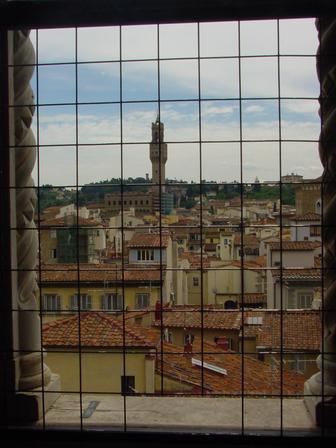
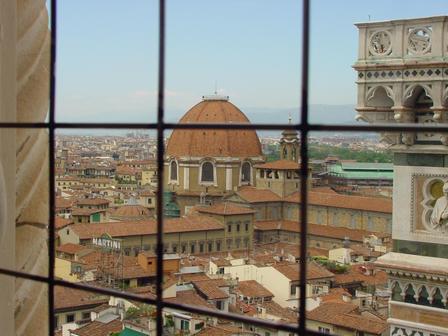
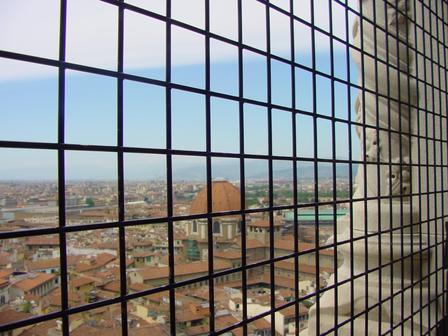
We climbed up to the tower and took all these excellent pictures of the city.
It was very interesting to check out the weathering of the building stones. Some of these buildings are at least 600-800 years old and one could really see how the different rocks weather though time. In the buildings, they used different rocks because of the color combinations they could create, and they did not think about their durability. Probably one of their worst choices was the red "ammonitico roosso" limestone and the green serpentinite. In just about every city we visited, those weathered the most.
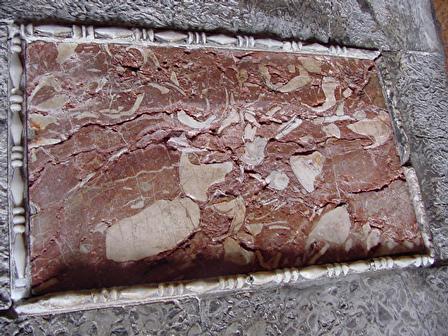
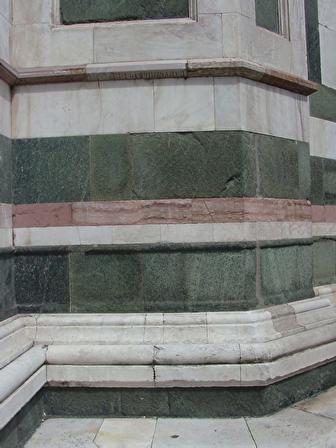
After the duomo we went to see the
Baptistry.
The octagonal Florence Baptistery, standing in front of the famous Duomo, is one of the oldest buildings in the city. It is renowned for Ghiberti's 15th century bronze "Gates of Paradise", whose creation is sometimes cited as the dawn of the Renaissance. The mosaics on the inside of the Baptistery are of earlier origin. Work began on the arch over the altar in 1225 and continued to cover the entire roof vault during the next hundred years or so. The designs (cartoons) for the mosaics were provided by some of the finest Florentine artists of the pre-Renaissance era, including Coppo di Marcovaldo, who was responsible for the cartoon for this picture of Christ in judgment.
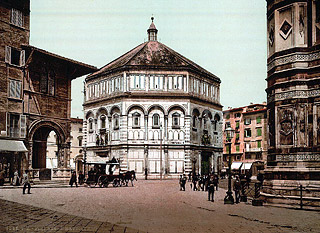
print.exploitz.com/ The-Baptistry-Florence-art.php
THE MUSEUM OF THE
"CATHEDRAL"
The MUSEUM OF THE CATHEDRAL ("Museo dell'Opera del Duomo") houses
artworks from the Gothic Cathedral, the Baptisty and the Tower of Giotto
(campanile). The most important works in the museum are by Michelangelo
("Pietà"), Donatello ("Mary Magdalen"), Arnolfo di Cambio ("Boniface
VIII") and Luca della Robbia ("Cantoria").
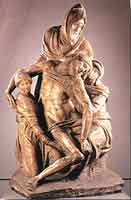 Michelangelo's
Pieta
Michelangelo's
Pieta
http://www.aboutflorence.com/museums-in-Florence.html
We had lunch in a little restaurant close to the Uffici museum. We tried to get in there too, but there was a three-four hour line. We all decided, to go and see Pisa instead.
Before Pisa we walked some more in Florence crossing the Ponte Vecchio bridge. This is also called the gold bridge, because every little window you can see on the picture below belongs to a jewelry store. One can buy some of the cheapest world famous Italian gold jewelry here.

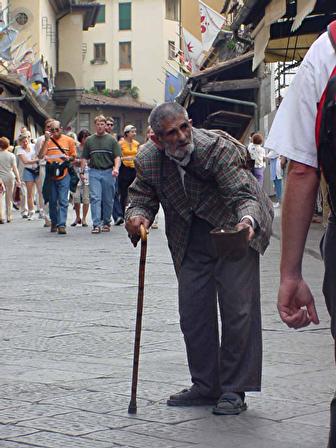
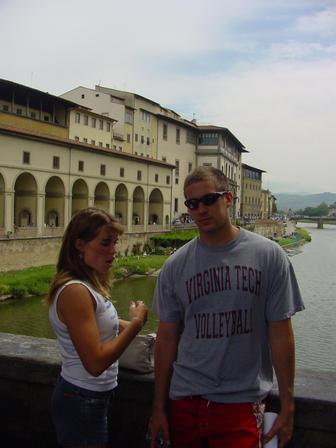
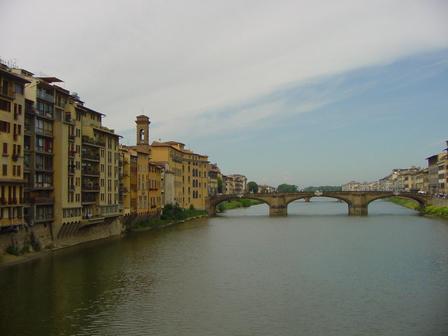
Around 4 p.m. we were really tired, so we took the bus back to the parking area and left for Pisa.
PIsa
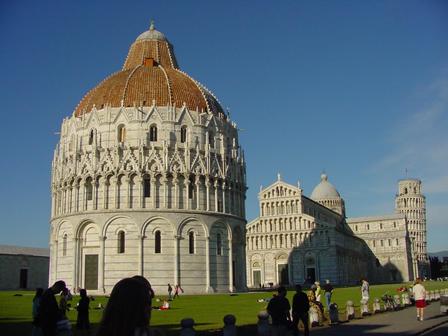
The Tower of Pisa is the
bell tower of the Cathedral. Its construction began in the august of
1173 and continued (with two long interruptions) for about two hundred
years, in full fidelity to the original project, whose architect is
still uncertain.
In the past it was widely believed that the inclination of the Tower was
part of the project ever since its beginning, but now we know that it is
not so. The Tower was designed to be "vertical" (and even if it did not
lean it would still be one of the most remarkable bell towers in
Europe), and started to incline during its construction.
Both because of its inclination, and its beauty, from 1173 up to the
present the Tower has been the object of very special attention. During
its construction efforts were made to halt the incipient inclination
through the use of special construction devices; later columns and other
damaged parts were substituted in more than one occasion (http://torre.duomo.pisa.it/index_eng.html).
On the way back to our hostel in Lucca, we took a smaller road and found a country restaurant. We had a great ethnic dinner, in a beautiful environment in Tuscany.